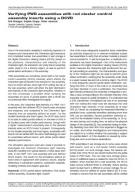Details
- Identification
- ISSN: 1977-5296, DOI: 10.3011/ESARDA.IJNSNP.2019.4
- Publication date
- 1 June 2019
- Author
- Joint Research Centre
Description
Volume: 58, June 2019, pages 35-40,
Authors: Erik Branger, Sophie Grape, Peter Jansson
Uppsala University
Abstract:One of the instruments available to authority inspectors to measure and characterize the Cherenkov light emissions from irradiated nuclear fuel assemblies in wet storage is the Digital Cherenkov Viewing Device (DCVD). Based on the presence, characteristics and intensity of the Cherenkov light, the inspectors can verify that an assembly under study is not a dummy object, as well as perform partial defect verification of the assembly.
PWR assemblies are sometimes stored with a rod cluster control assembly (RCCA) inserted, which affects the Cherenkov light production and transport in the assembly. Such an insert will also block light from exiting the top of the fuel assembly, which will affect the light distribution and intensity of the Cherenkov light emissions. Whether or not this constitutes a problem when verifying the assemblies for gross or partial defects with a DCVD has not previously been investigated thoroughly.
In this work, the Cherenkov light intensity of a PWR 17x17 assembly with two different RCCA inserts were simulated and analysed, and compared to the Cherenkov light intensity from an assembly without an insert. For the studied assembly and insert types, the DCVD was found to be able to detect partial defects on the level of 50% in all studied cases with similar performance, though with a higher measurement uncertainty due to the reduced intensity when an RCCA insert is present. Consequently, for the studied assembly and insert types, assemblies with inserts can be verified with the same methodology as used for assemblies without inserts, with similar partial defect detection performance.
The simulation approach used also made it possible to investigate the minimum Cherenkov light intensity reduction resulting from partial defects of other levels than 50%, in the PWR 17x17 fuel assembly with and without RCCA inserts. The results for the simulations without an insert were in agreement with previous results, despite differences in substitution patterns, substitution materials, modeling software and analysis approach.
Keywords: DCVD; partial defect verification; Rod cluster control assembly, Cherenkov light; Geant4.
Reference guideline:
Branger, E., Grape, S., & Jansson, P. (2019). Verifying PWR assemblies with rod cluster control assembly inserts using a DCVD. ESARDA Bulletin - The International Journal of Nuclear Safeguards and Non-proliferation, 58, 35-40. https://doi.org/10.3011/ESARDA.IJNSNP.2019.4

